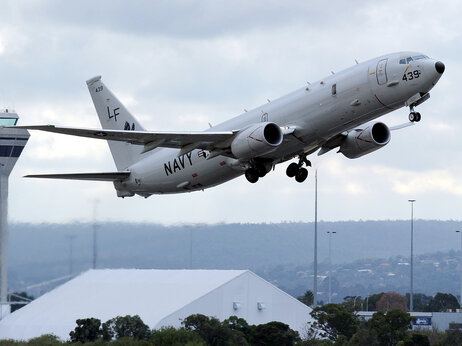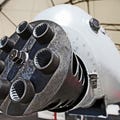U.S. Sends Second Carrier to Asia Amid Tensions with China
August 23, 2014
By Bill Gertz
The Navy is sending a second aircraft carrier strike group to the Asia Pacific region amid new tensions with China over a dangerous aerial encounter between a Chinese interceptor and Navy P-8 surveillance craft.
The strike group led by the USS Carl Vinson departed San Diego for the Pacific on Friday, the Navy said in an announcement of what it terms a “planned” deployment.
China’s military on Saturday, meanwhile, demanded an end to all U.S. monitoring flights and called U.S. criticism of dangerous Chinese jet maneuvers false.
Chinese Defense Ministry spokesman Yang Yujun said in a statement that a Chinese fighter jet made a “regular identification and verification” of the Navy P-8 anti-submarine warfare jet during an encounter in an area 135 miles east of Hainan Island.
Yang called Pentagon criticism of the incident “totally groundless” and insisted the Chinese pilot operated professionally and kept a safe distance.
The Chinese spokesman’s account, published in the state-run Xinhua news agency, is at odds with Pentagon officials who called the encounter both dangerous and aggressive. A White House official also said the dangerous intercept was a Chinese “provocation.”
Pentagon spokesman Rear Adm. John Kirby on Friday called the maneuvers by the Chinese J-11—a Russian design Su-27—a dangerous and unprofessional encounter and said the military has protested the incident to the Chinese military.
“We have registered our strong concerns to the Chinese about the unsafe and unprofessional intercept, which posed a risk to the safety and the well-being of the air crew and was inconsistent with customary international law,” Kirby said, adding that the pilot of the J-11 was “very, very close; very dangerous.”
Asked Saturday about Yang’s assertion, Kirby told the Free Beacon: “We stand by our account of this dangerous and unprofessional incident.”
The Carl Vinson strike group will patrol “both 5th and 7th Fleet areas of responsibility.” The 7th fleet covers the Pacific and the 5th Fleet is responsible for operations in the Middle East, the Navy statement said.
The guided missile cruiser USS Bunker Hill and three guided missile destroyers, the USS Gridley, USS Sterett, and USS Dewey also deployed with the Vinson.
The Vinson will join the Japan-based USS George Washington strike group.
Earlier, Pentagon spokesman Lt. Col. Jeff Pool said in a statement that the aerial incident took place 135 miles east of Hainan Island when the J-11 came within 20 feet of a U.S. Navy P-8 anti-submarine warfare aircraft.
“The intercept was aggressive and demonstrated a lack of due regard for the safety and well-being of the U.S. and Chinese aircrews and aircraft,” Pool said, adding that the incident was of the most dangerous aerial encounters with the Chinese since the April 2001 EP-3 mid-air collision with a Chinese J-8.
The P-8 was on a routine mission in international airspace when the Chinese jet sought to intimidate the crew with several dangerous maneuvers, including a barrel roll over the top of the militarized Boeing 737 jet.
“On three different occasions, the Chinese J-11 crossed directly under the U.S. aircraft with one pass having only 50 to 100 feet separation between the two aircraft,” Pool said. “The Chinese jet also passed the nose of the P-8 at 90 degrees with its belly toward the P-8 to show its weapons loadout.”
“In doing so, the pilot was unable to see the P-8, further increasing the potential for a collision,” Pool said. “The Chinese pilot then flew directly under and alongside the P-8 bringing their wingtips within 20 feet and then before he stabilized his fighter he conducted a roll over the P-8 passing within 45 feet.”
The latest incident followed earlier intercepts that the Pentagon said were “nonstandard, unprofessional and unsafe intercepts of U.S. aircraft.”
Additionally, the aggressive interceptor was based at the same unit on Hainan Island that conducted similar aggressive intercepts in March, April, and May.
“We are concerned that the intercepting crews from that unit are acting aggressively and demonstrating a lack of regard for the regard for the safety of our aircrews,” Pool said. “We have raised our concerns over this unsafe behavior to the PRC.”
Deputy White House Deputy National Security Adviser Ben Rhodes told reporters the Chinese aerial encounter was “a deeply concerning provocation.”
Both the Pentagon and White House comments were unusually harsh for the Obama administration, which has sought to play down dangerous and threatening military developments by the Chinese.
Yang stated that “massive and frequent close-in surveillance of China” endangers air and maritime security and is at the root of accidents.
China is urging the United States to abide by international law and international practices and to respect the concerns of coastal countries, Yang said, adding that Washington should properly deal with the differences between the two nations on air and maritime security issues.
Yang said the United States should abide by the principle of “non-conflict, non-confrontation, mutual respect and win-win cooperation, take concrete actions, reduce and finally stop close-in surveillance of China, so as to create a sound atmosphere for bilateral military ties.”
Pool, the Pentagon spokesman, said in his statement Friday that U.S. monitoring is legal.
“Under international law, as reflected in the 1982 Law of the Sea Convention, military activities may be conducted within the Exclusive Economic Zone of another nation as an exercise of the freedoms of navigation and overflight,” he said. “Coastal states, including China, shall have due regard for the rights and duties of other States, including in the exercise of these freedoms.”
The aerial encounter comes amid a toughening posture by China in the South China Sea.
U.S. officials said Chinese official statements related to the ASEAN Regional Forum in early August revealed that China had no plans to back off aggressive claims in the South China Sea and is pushing hard to block U.S. involvement in the regional dispute.
Chinese Foreign Minister Wang Yi rejected a U.S. proposal to voluntarily freeze destabilizing action in disputed waters, such as China’s placement of an oil-drilling rig in the South China Sea.
China also announced it was stepping up activities in disputed areas of the sea, challenging claims by Vietnam, Philippines and other nations.
Until the Defense Ministry statement Saturday, China’s government had remained silent on the Su-27 encounter with the P-8.
Most state-run news outlets in China did not cover the affair, with major newspapers and wire services ignoring the story. Only CCTV, the state television network, reported on the Aug. 19 incident.
CCTV’s report from the network’s Washington correspondent quoted unspecified “Chinese experts” as saying the P-8 “posed a threat to their country’s military security over the South China Sea.”
The White House said Friday through Ben Rhodes, deputy national security advisers, that the Chinese jet, which conducted a barrel roll over the P-8 some 135 miles east of Hainan Island was a “provocation.”




 Reply With Quote
Reply With Quote

 Pentagon Press Secretary Rear Adm. John Kirby. Photo by PAUL J. RICHARDS/AFP/Getty Images
Pentagon Press Secretary Rear Adm. John Kirby. Photo by PAUL J. RICHARDS/AFP/Getty Images



 Tyler Rogoway
Tyler Rogoway
 Expand
Expand Expand
Expand
Bookmarks